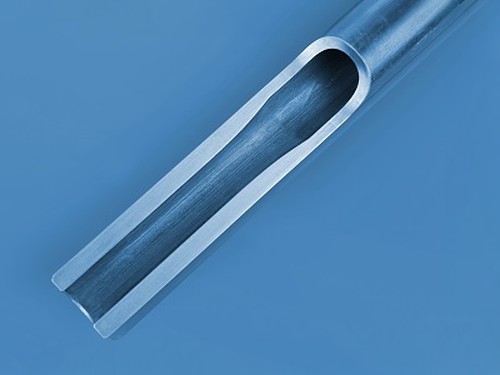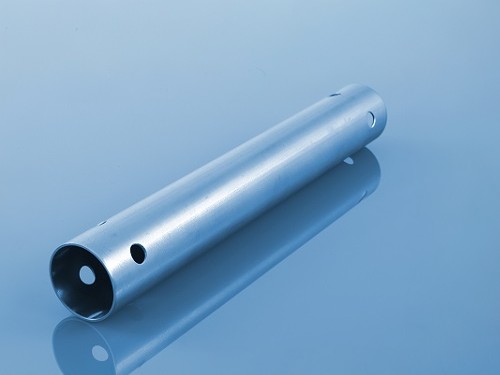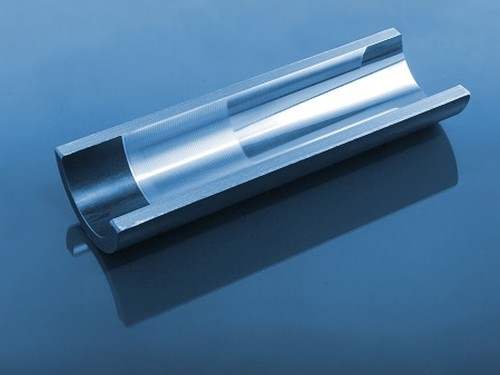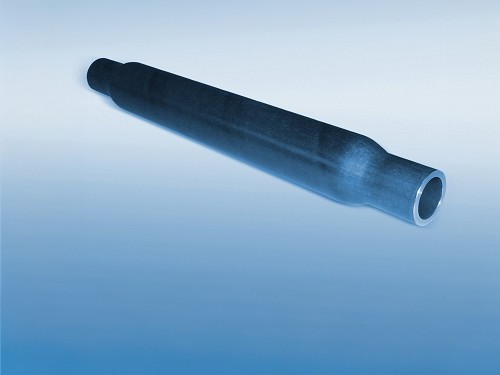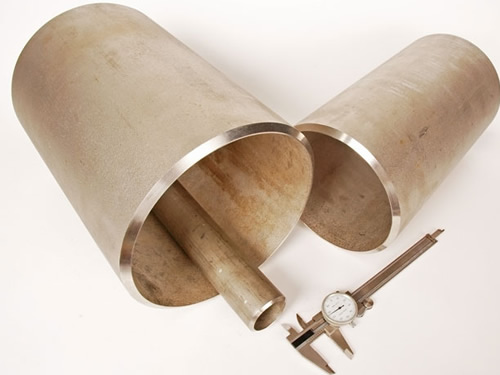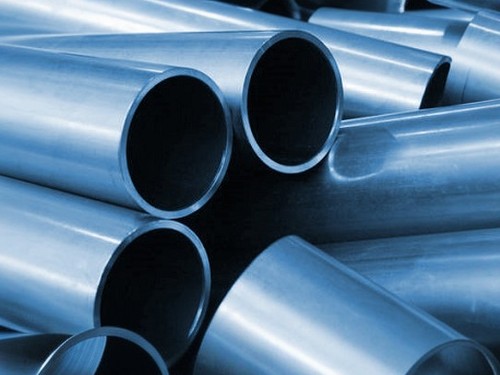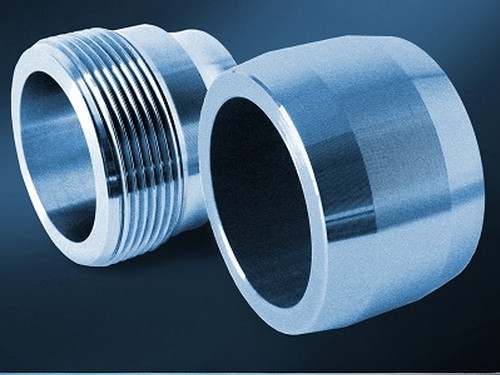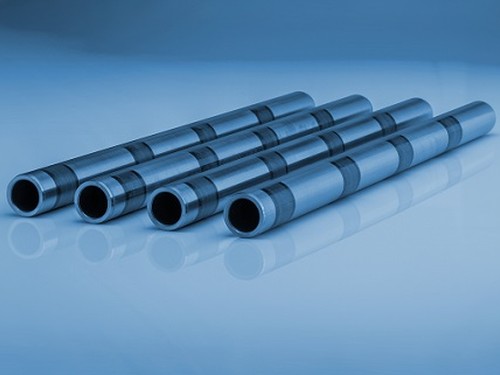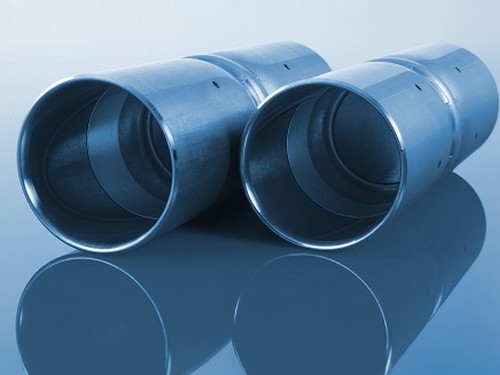
JIS G3455 STS 410 seamless carbon steel pipes are used for high pressure service at an approximate maximum temperature of 350℃.
JIS G3455 STS 410 is a grade of carbon steel pipes specified under the Japanese Industrial Standard (JIS) G3455. The standard covers carbon steel pipes for high-pressure service at an approximate maximum temperature of 350°C.
STS 410 is a medium strength grade compared to STS 480 and STS 510. The mechanical properties of STS 410 carbon steel pipes can be varied through heat treating. By controlling the heating and cooling cycle, the desired properties are obtained by producing predictable changes in the microstructure of the steel.
These carbon steel pipes are commonly used in industrial applications where high-pressure and high-temperature conditions are present, such as steam boilers, pipelines, and high-pressure equipment. The minimum tensile strength of STS 410 is 412 MPa and the minimum yield strength is 245 MPa.
In summary, JIS G3455 STS 410 is a medium strength grade of carbon steel pipes used for high-pressure service at high temperatures. The mechanical properties of STS 410 can be varied through heat treating, making it suitable for a variety of industrial applications where harsh conditions exist.
These carbon steel pipes are designed to withstand high-pressure and high-temperature conditions, making them suitable for use in applications such as steam boilers, pipelines, and high-pressure equipment. The pipes are manufactured through a seamless process or a welded process, depending on the requirements of the application.
The mechanical properties of JIS G3455 carbon steel pipes vary depending on the grade. For example, STS 370 has a minimum tensile strength of 370 MPa and a minimum yield strength of 215 MPa, while STS 510 has a minimum tensile strength of 510 MPa and a minimum yield strength of 335 MPa.
| Letter symbol of grade | Hot-finished seamless steel pipe | Cold-finished seamless steel pipe |
|---|---|---|
| STS 410 | As manufactured. However, low temperature annealing of normalizing may be applied, as necessary. | Low temperature annealed of normalized |
| Grade | Chemical Composition % | ||||
|---|---|---|---|---|---|
| C | Si | Mn | P | S | |
| STS 410 | 0.30 max. | 0.10~0.35 | 0.30~1.40 | 0.035 max. | 0.035 max. |
| Letter symbol of grade | Mechanical Properties | |||||
|---|---|---|---|---|---|---|
| Tensile strength | Yield strength | Elongation % | ||||
| kgf/m㎡ {N/ m㎡} | kgf/m㎡ {N/ m㎡} | No.11 and No.12 test pieces | No. 5 test pieces | No. 4 test piece | ||
| Longitudinal | Transverse | Longitudinal | Transverse | |||
| STS 410 | 42{412}min | 25{245} min | 25 min | 20 min | 19 min | 24 min |
(1)The pipe are practically straight, and its both ends shall be at a right angle to its axis.
(2) The inside and outside surfaces of the pipe shall be well-finished and free form defects that are detrimental to practical use.
(1)Chemical analysis
(2)Tensile Test
(3)Flattening Test
(4) Bending Test
(5) Hydrostatic Test or Nondestructive Examination
| Division | Tolerances on outside diameter | Tolerances on wall thickness | Tolerances on wall thickness deviation |
|---|---|---|---|
| Hot-finished seamless steel pipe | 50mm Under 【0.5mm | ≤4mm Under +0.6mm -0.5mm ≤4mm or over +15% -12.5% |
Within 20% of wall thickness |
| 50mm or over 200mm to and excl. 【1.6mm |
|||
| 200mm of over 【0.8% | |||
| For the pipe 350mm of over, the tolerances on outside diameter may be determined by the measurement of the length of circumference. shall be 【0.5%. |
|||
| Cold-finished seamless steel pipe | 40mm Under【0.3mm | ≤2mm Under 【0.2mm |
- |
| 40mm of over 【0.8% | ≤2mm or over 【10% |
||
| For the pipe 350mm or over, the tolerances on outside diameter may be determined by the measurement of the length of circumference, In this case, the tolerances shall be 【0.5%. |
Japanese Industrial Standards (JIS) developed by the organization apply to a wide variety of industrial services and technologies such as automobiles, metallurgy, ships and medical equipment
The method for making cold-drawn seamless pipes involves taking a round “billet” or bar of steel and boring it in the center, turning it, cutting it, heating it to make it more pliable, then “drawing” it (extruding or pulling it) to make it a longer and thinner tube.
Japanese Industrial Standards specifies the standards used for industrial activities in Japan. The standardization process is coordinated by Japanese Industrial Standards Committee and published through Japanese Standards Association.
The Industrial Standardization Law was revised in 2004 and the JIS mark product certification system was changed. Standards are named like “JIS X 0208:1997″, where X denotes area division, followed by four digits (or five digits for some of the standards corresponding ISO standards) and the revision release year.
EN 10204:2004 is for metallic products-and this norm tell us things about Types of inspection documents. There are no material standards.
Mostly material is defined with its chemical composition and mechanical properties in a public standars like ISO, EN, JIS, ASTM etc.
Japanese Industrial Standards (JIS) specifies the standards used for industrial activities in Japan. The standardization process is coordinated by Japanese Industrial Standards Committee and published through Japanese Standards Association.
Table 1: Tolerance on Outside Diameter in JIS G3441, G3444, G3445
| Standard | Tolerance on outside diameter (mm) | |
|---|---|---|
| JIS G3441 JIS G3444 JIS G3445 |
=50 | ±0.5 |
| >50 | ±1% | |
| JIS G3441 JIS G3444 JIS G3445 |
<50 | ±0.25 |
| >50 | ±0.5% | |
| JIS G3441 JIS G3445 |
<25 | ±0.12 |
| >25-40 | ±0.15 | |
| >40-50 | ±0.18 | |
| >5:.60 | ±0.20 | |
| >60-70 | ±0.23 | |
| >70-80 | ±0.25 | |
| >80-90 | ±0.30 | |
| >90-100 | ±0.40 | |
| >100 | ±0.5% | |
| JIS G3441 | <13 | ±0.25 |
| >13-25 | ±0.40 | |
| >25-40 | ±0.60 | |
| >40-65 | ±0.80 | |
| >65-90 | ±1.00 | |
| >90-140 | ±1.20 | |
| >140 | By agreement | |
| Standard | Tolerance on wall thickness (mm) | |
|---|---|---|
| JIS G3441 JIS G3444 JIS G3445 |
<=4 | -0.5,+0.6 |
| >4 | -12.5%, +15% | |
| JIS G3441 JIS G3444 JIS G3445 |
<=3 | ±0 .3 |
| >3 | ±10% | |
| JIS G3441 JIS G3445 |
<=2 | ±0.15 |
| >2 | ±8% | |
| Process | Tolerance on outside diameter | Tolerance on wall thickness | ||
|---|---|---|---|---|
| <40A | ±0.5mm | <=4mm | +0.6mm -0.5% |
|
| >50A, <125A | ±1% | |||
| Hot Rolled Seamless Pipes |
150A | ±1.6mm | >4mm | +15% -12.5% |
| >200A | ±0.8% | |||
| More than 350mm,the Tolerance is ±0.5% |
||||
| Cold Drawn Seamless Pipes and Electric Resistant Welded Pipes |
<25A | ±0.3mm | <=3mm | ±0.3mm |
| >32A | ±0.8% | >3mm | ±10% | |
| But more than 350mm, the Tolerance is ±0.5% |
||||
| Process | Tolerance on outside diameter | Tolerance on wall thickness | ||
|---|---|---|---|---|
| Hot Rolled Seamless Pipes |
<=50mm | ±0.5mm | <=4mm | ±0.5mm |
| >50-160mm | ±1% | |||
| >160-200mm | ±1.6mm | >4mm | ±12.5% | |
| >200mm | ±0.8% | |||
| More that 350mm, the Tolerance is ±0.5% |
||||
| Cold Drawn Seamless Pipes and Electric Resistant Welded Pipes |
<=40mm | ±0.3mm | <=2mm | ±0.2mm |
| >40mm | ±0.8% | >2mm | ±10% | |
| More than 350 mm the Tolerance is ±0.5% |
||||
| O.D. | Tolerance on outside diameter | ||||
|---|---|---|---|---|---|
| Hot rolled seamless pipes | Seamless pipes through quench and normalized | Cold drawn seamless pipes throng, the hot treatment except quench and normalized | Electric welded pipes except cold drawn | Cold drawn electric welded pipes | |
| mm | |||||
| <=25 | +0.4 -0.8 |
±0.25 | ±0.10 | ±0.15 | ±0.10 |
| >25.40 | ±0.25 | ±0.15 | ±0.20 | ±0.15 | |
| >40-50 | ±0.25 | ±0.20 | ±0.25 | ±0.20 | |
| >50.60 | ±0.25 | ±0.25 | ±0.30 | ±0.25 | |
| >60-80 | ±0.30 | ±0.30 | ±0.40 | ±0.30 | |
| >80.100 | ±0.40 | ±0.40 | -0.60,+0.40 | ±0.40 | |
| >100-120 | +0.4 -1.2 |
-0.60,+0.40 | -0.60,+0.40 | -0.80,+0.40 | -0.60,+0.40 |
| >120-160 | -0.80,+0.40 | -0.80,+0.40 | -1.00,+0.40 | -0.80,+0.40 | |
| >160-200 | -1.8,+0.4 | -1.20,+0.40 | -1.20,+0.40 | -1.20,+0.40 | -1.20,+0.40 |
| >200 | -2.4,+0.4 | -1.60,+0.40 | -1.60,+0.40 | -1.60,+0.40 | -1.60,+0.40 |
| Wall thickness (mm) |
Hot rolled seamless pipe | Cold drawn seamless pipe | Electric welded pipe | |||
|---|---|---|---|---|---|---|
| O.D(mm) | O.D(mm) | O.D(mm) | ||||
| <=100 | >100 | <=40 | >40 | <=40 | >40 | |
| (%) | ||||||
| <=2 | – | – | -0,+0.4mm | +22 -0 |
-0,+0.3mm | +18 0 |
| >2-2.4 | -0,+40 | – | +20 -,0 |
+18 -0 |
||
| >2.4-3.8 | -0,+35 | -0,+35 | ||||
| >3.8-4.6 | -0,+23 | -0,+33 | ||||
| >4.6 | -0,+28 | -0,+28 | ||||
| Item | Tolerance an length | |
|---|---|---|
| OD<50mm | <7m | -0, +7mm |
| >=7m | Every 3m increase in length, the plus tolerance be increased by 3mm with a maximum of 15mm | |
| OD>=50mm | <7m | -0, +10mm |
| >=7m | Every 3m increase in length, the plus tolerance be increased by 3mm with a maximum of 15mm | |
| OD: Outside Diameter | ||
| Process | Tolerance on outside diameter (mm) | |
|---|---|---|
| Hot Rolled | <=50 | ±0.5 |
| >50 | ±1% | |
| Cold Drawn | <=40 | ±0.2 |
| >40 | ±0.5% | |
| JIS | ASTM | BS | DIN | NF | ISO | Index Number | ||||||||||||
|---|---|---|---|---|---|---|---|---|---|---|---|---|---|---|---|---|---|---|
| Standard Number | Grade | Tupe | Standard Number | Grade | Tupe | Standard Number | Grade | Tupe | Standard Number | Grade | Tupe | Standard Number | Grade | Tupe | Standard Number | Grade | Tupe | |
| G3456 | STPT370 (STPT38) |
C | A106 | GrA | C | 3602 | HFS360 | C | 17175 | St35.8 | C | A49-211 | TU37b | C | 2604/2 | TS5 | C | C004 |
| " | CFS360 | C | 17177 | St37.8 | C | A49-213 | TU37c | C | 2604/3 | TW9H | C | |||||||
| " | ERW360 | C | A49-243 | TU37c | C | |||||||||||||
| " | CEW360 | C | ||||||||||||||||
| STPT410 (STPT42) |
C | A106 | GrB | C | 3602 | HFS410 | C | 17175 | St45.8 | C | A49-211 | TU42b | C | 2604/2 | TS9H | C | ||
| " | CFS410 | C | 17177 | St42.8 | C | A49-213 | TU42c | C | ||||||||||
| " | ERW410 | C | A49-243 | TU42c | C | |||||||||||||
| " | CEEW410 | C | ||||||||||||||||
| STPT480 (STPT42) |
C | A106 | GrC | C | 3602 | HFS460 | C | A49-211 | TU48b | C | 2604/2 | TS14 | C | |||||
| " | CFS460 | C | A49-213 | TU48c | C | |||||||||||||
| " | ERW460 | C | ||||||||||||||||
| " | CEEW460 | C | ||||||||||||||||
In the Meiji era, private enterprises were responsible for making standards. However, the Japanese government did have standards and specification documents for procurement purposes for certain articles, such as munitions. These were summarized to form an official standard old JES in 1921. During World War II, simplified standards were established to increase matériel output. The Industrial Standardization Law was enacted in 1949, which forms the legal foundations for the present Japanese Industrial Standards.
JIS seamless pipe according to alloy, stainless steel or carbon. It tests steel’s properties, hardness, resistance to corrosion, pitting, heat treating processes and others. The results are listed in a main JIS steel grade for steel pipe as below.
Seamless Steel Oil Well, Casing, Tubing and Drill Pipe
Steel grade: STO-G, STO-H, STO-J, STO-N, STO-C, STO-D, STO-E
Application: Seamless Steel Oil Well, Casing, Tubing and Drill Pipe
Steel grade:SCr 420TK, SCM415TK, SCM418TK, SCM420TK, SCM430TK, SCM435TK, SCM440TK
Application:Alloy Steel Tubes for General Structural Purpose
Steel grade: STK 30, STK 41, STK 50, STK 51, STK 55
Application: Carbon Steel Tubes for General Structural Purpose
Dimension Range: 21.7-1016.0 mm
Application: Carbon Steel Tubes for Machine Structural Purposes
Steel grade: STS 38, STS 42, STS 49
Application: Carbon Steel Pipes for High Pressure Service
Dimension Range: 10.5-660.4 mm
Steel grade: STPT 38, STPT 42, STPT 49
Application: Carbon Steel Pipes for High Temperature Service
Dimension Range:10.5-660.4 mm
Steel grade:STPL 39, STPL 46, STPL 70
Application: Steel Pipes for Low Temperature Service
Dimension Range:10.5-660.4 mm
Steel grade: STBL 39, STBL46, STBL 70
Application: Steel Heat Exchanger Tubes for Low Temperature Service
Dimension Range: 15.9-139.8 mm
Steel grade: STM-055, STM-C65, STM-R60, STM-1170, STM-1180, STM-R85
Application: Seamless Steel Tubes for Drilling
Dimension Range: Casing: 43-142mm / Hollow Pipes: 34-180mm / Drilling:33.5-50mm
Steel grade: STF 42, STFAl2, STFA22, STFA23, 5TFA24, STFA23, STFA26
Application:Steel Tubes for Fired Heater
Dimension Range:60.5-267.4mm
JIS G 3101 SS400 is one of the most commonly used hot rolled general structural steel.
SS400 is a Japanese brand of ordinary steel products
With years of expertise, we provide a diverse array of steel tube processing options. From sawing and machining tube blanks to intricate bending and upsetting operations, we actively assist you throughout your projects.
Our capabilities extend to eccentricity reduction and concentricity enhancement through turning and grinding. We excel in creating complex geometries using processes like rotary swaging and axial forming. Additionally, we offer property modifications via partial heat treatment, ensuring tailored solutions for your specific needs.
